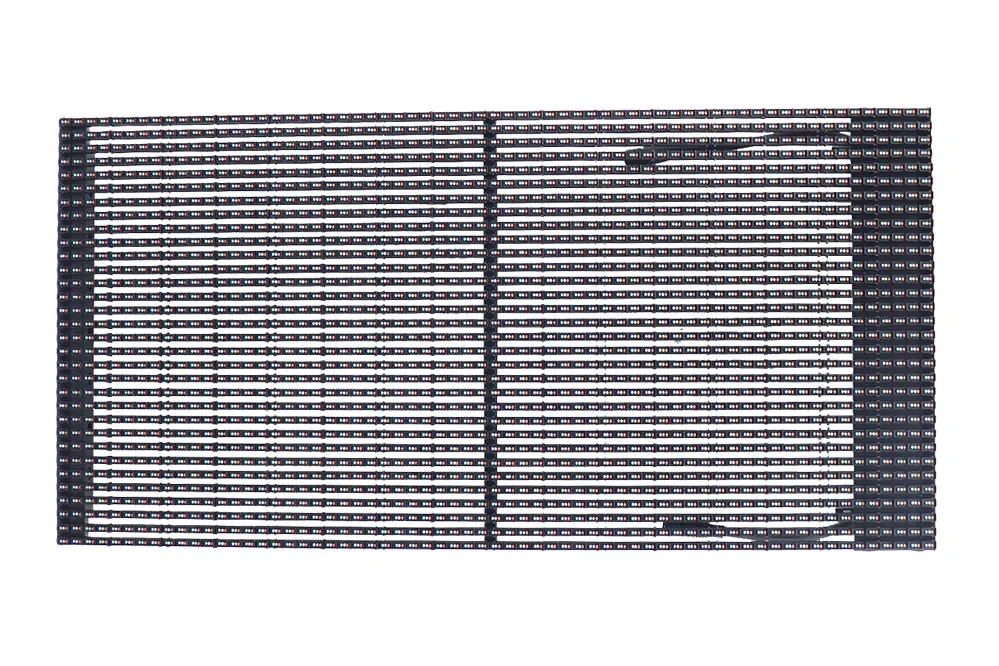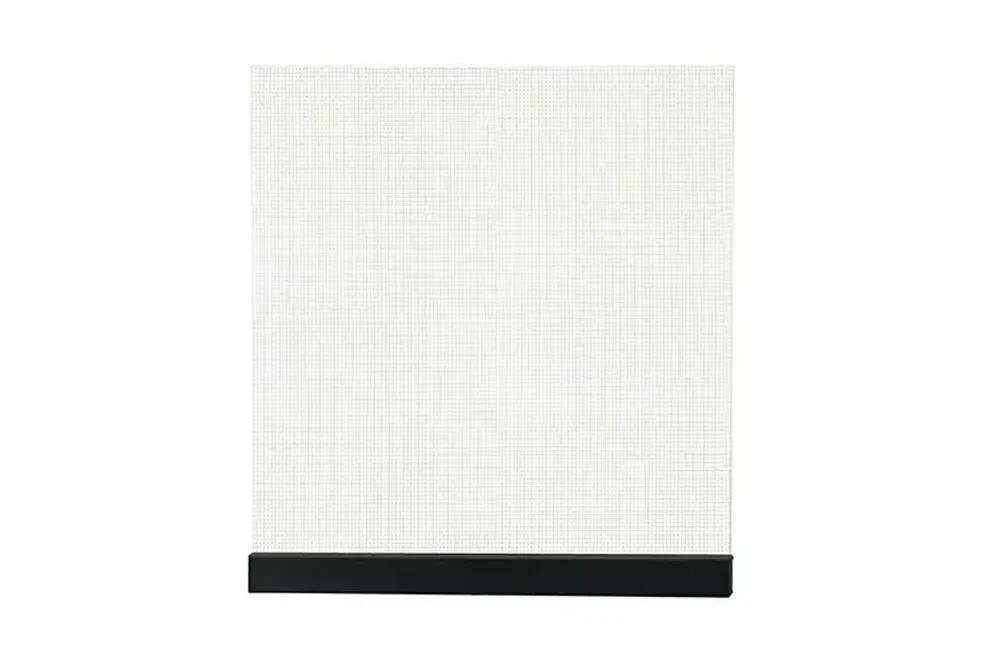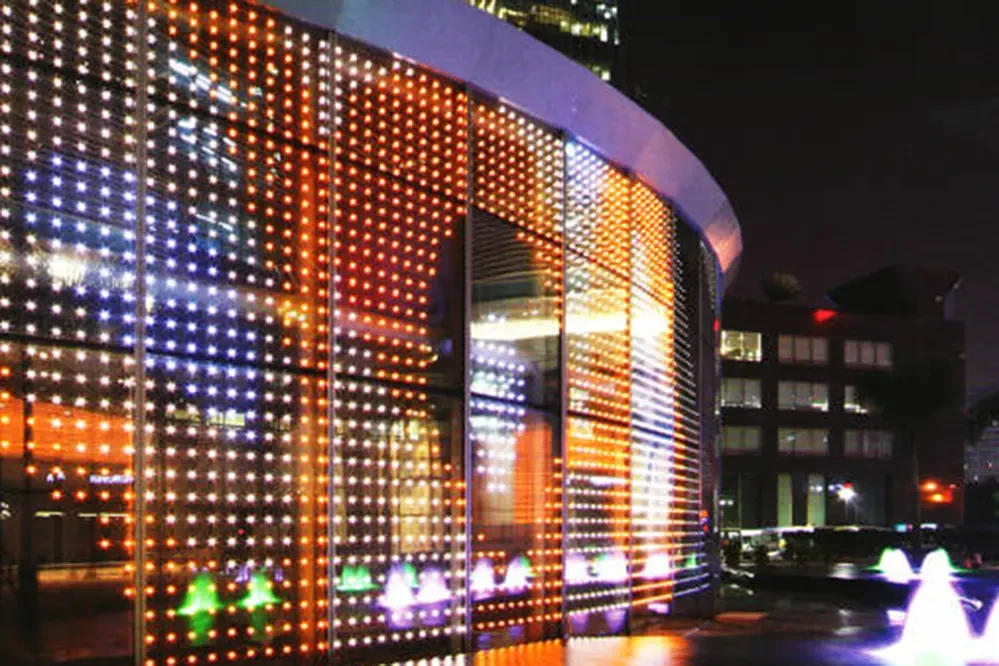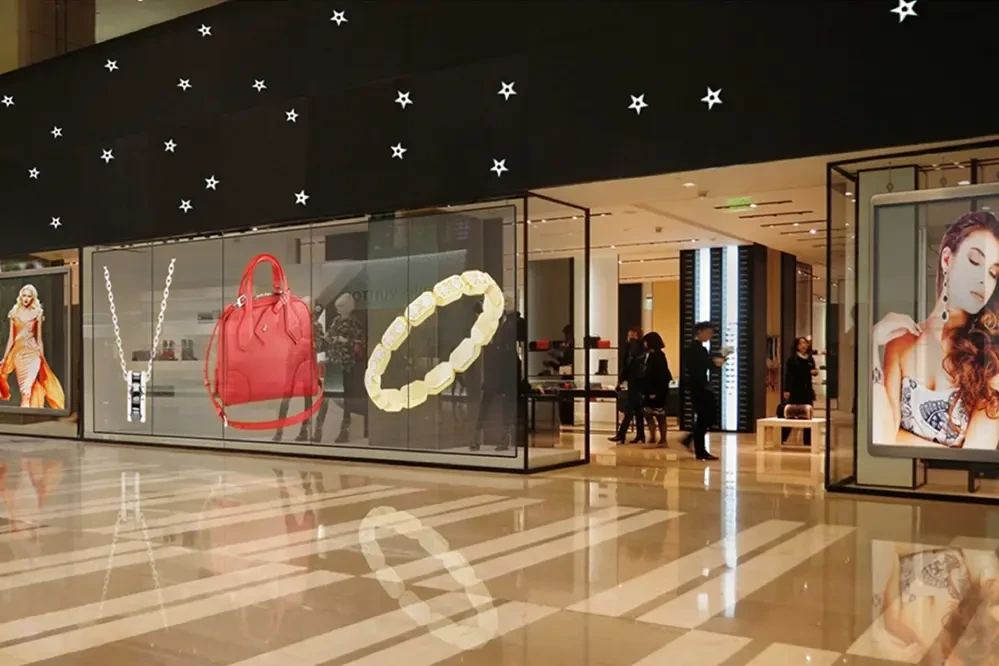Comparative Analysis: LED Grid Display vs. Transparent LED Display
Are you tired of outdated digital displays that clutter your view and fail to impress? The debate of LED grid display vs. transparent LED display is more relevant than ever. Traditional LED grid displays, with their bulky structures and limited transparency, are being challenged by the sleek, modern transparent LED displays that offer unparalleled visual clarity and integration.
One common misconception is that all LED displays are created equal. However, the differences between LED grid displays and transparent LED displays are vast. LED grid displays, with their grid-like pattern of light strips, often obstruct the view and require numerous mounting brackets, making them less desirable for modern applications. On the other hand, transparent LED displays integrate seamlessly with glass surfaces, providing a cleaner and more sophisticated look.
The benefits of transparent LED displays are numerous. They offer higher resolution, greater transparency, and a more refined display effect, making them ideal for close-range viewing and high-end commercial applications. In contrast, LED grid displays are better suited for long-distance outdoor scenarios where high brightness and wind resistance are crucial.
In this article, we will cover key points such as structural design, transparency, display effect, application scenarios, and maintenance and installation. Each section will provide a detailed comparison to help you understand why transparent LED displays are becoming the go-to choice for innovative visual solutions.
So, if you're ready to explore the future of digital displays and learn why transparent LED displays are outshining their predecessors, read on. This comprehensive analysis will equip you with the knowledge to make informed decisions about your next digital display investment.
Overview of LED Display Technologies
LED display technologies have transformed modern visual communication.
Traditional LED grid displays have been prevalent for over a decade. They consist of LED bulbs embedded in bar-shaped light strips placed in a grid-like pattern, creating a fence-like appearance. Interestingly, due to their design, they provide bright and durable solutions for large-scale outdoor applications.
Modern advancements introduced transparent LED screens.
These feature high-density LED bulbs embedded in transparent substrates, achieving higher resolution and visual finesse. The innovation enables these displays to blend impeccably with their environment, making them ideal for high-end indoor applications.
Both technologies embody diverse strengths and applications, reflecting the dynamic evolution of display solutions. Transparent LED displays represent the latest innovation for scenarios demanding high aesthetic integration, while LED grid displays maintain relevance for robust outdoor installations.
Structural Design Comparisons
LED grid displays utilize a network of bar-shaped light strips with embedded LED bulbs, creating a fence-like structure. This results in a robust yet visible frame, suitable for outdoor installations demanding durability.
In contrast, transparent LED displays incorporate high-density LED bulbs into a transparent PCB substrate. This refined structure provides superior transparency and seamless integration with transparent surfaces.
LED Grid Display Construction

LED grid displays consist of bar-shaped light strips arranged in a grid-like pattern.
Each strip is equipped with embedded LED bulbs, creating a mesh-like appearance when assembled.Due to the large spacing between the strips, a fence-like structure is achieved, which makes the display robust yet visibly prominent. This structural characteristic lends itself ideally to durable outdoor setups.
This simple yet sturdy construction, while highly functional, affects the display's visual fineness, making it more suited to long-distance viewing applications.
Transparent LED Display Construction

Transparent LED displays represent the pinnacle of innovative visual technology, seamlessly blending digital content with real-world surroundings.
At the heart of this technology is a transparent PCB substrate, intricately embedded with high-density LED bulbs. The result is a refined, translucent surface capable of displaying vibrant images and videos.
One of the key advantages of this construction is its remarkable transparency, often reaching between 60% and 90%. This allows for unobstructed views through the display, ideal for environments requiring both display functionality and aesthetic appeal.
Due to the thinness of the LED film, typically around 2mm, the transparent LED display can be effortlessly integrated with glass surfaces, either adhered to the surface or sandwiched between glass panels. This eliminates the need for obtrusive mounting brackets, maintaining a sleek and uncluttered appearance.
This cutting-edge construction ensures that when the display is turned off, the surface retains its transparent nature, blending seamlessly with its environment, a perfect blend of form and function.
Transparency Levels and Visual Clarity
When comparing the transparency levels of LED grid displays and transparent LED displays, the differences are immediately apparent, and these nuances extend to visual clarity.
LED grid displays offer high transparency but can suffer from clarity issues.
The thick light strips in grid displays detract from the overall refinement and fineness of the content, making them suitable primarily for long-distance viewing where details are less critical.
In contrast, transparent LED displays achieve remarkable transparency levels of up to 90% and deliver exceptional visual clarity for close-range viewing. The dense arrangement of LEDs on a transparent PCB substrate results in sharper, more detailed images and videos, creating an immersive and visually appealing experience.
Display Resolution and Detail Quality
LED grid displays, due to their design with larger spacings, typically offer lower resolution. This structure is more apt for content visible from a distance, where intricacies are less pivotal to the observer’s experience, yet the information remains impactful at scale.
Conversely, transparent LED displays feature LEDs embedded within a transparent PCB substrate, which allows for denser deployment and higher resolution. This results in finer detail and higher image quality, making these displays ideal for close-range applications where the precision of visuals is paramount.
The terms "pixelated" and "crisp" distinctly differentiate the technologies, reflecting their respective strengths in resolution and detail quality.
Long-Distance Viewing
LED grid displays shine in long-distance viewing.
Designed with larger spacing between LED strips, these displays maintain visibility even from far away. The embedded LED bulbs project bright and bold visuals that stand out, which makes them particularly suitable for outdoor advertisements and sprawling facades. Consequently, viewers can effortlessly discern displayed information even from considerable distances.
Transparency is less critical.
The grid structure may compromise close-up visual intricacies, but excels in amplifying content visibility for larger audiences. This strength makes LED grid displays reliable for events, concert screens, and large signage, where viewability from various vantage points is crucial.
LED transparent displays or transparent LED screen, while highly detailed, lack the sheer visibility power at long ranges. They are tailored for environments prioritizing aesthetics and detail, thereby complementing more intimate, close-range engagements. Nonetheless, for settings requiring striking visuals from afar, LED grid displays remain the superior choice.
Close-Range Display
When it comes to close-range displays, nuances and intricacies become significantly more important.
For instance, a transparent LED screen is a revolutionary technology that excels in close-range scenarios. By carefully arranging high-density LED bulbs closely together on a transparent substrate, these displays achieve exceptional resolution and clarity, providing an engaging and immersive experience. The finer detail and smooth gradients make it ideal for settings such as high-end retail windows and indoor promotional spaces.
The enhanced resolution of LED transparent displays translates to a richer visual experience. When viewers get up close, the dynamic content appears vivid, with lifelike colors and detailed imagery. Such capabilities are perfect for captivating potential customers and conveying complex information in a visually appealing manner, ensuring that every nuance is conveyed effectively.
In contrast, traditional LED grid displays, with their bar-shaped light strips, are less suited for up-close viewing. The larger spacing between LEDs can result in a grainy appearance, where individual LED elements become visible, reducing overall image quality. Therefore, while LED grid displays may capture attention from a distance, LED transparent displays triumph in delivering a polished and sophisticated visual experience up close. This makes them the undisputed choice for settings demanding intricate displays, such as luxury boutiques, corporate lobbies, and exhibition spaces.
Typical Applications for LED Grid Displays

LED grid displays are quintessential for outdoor advertising, ideal for the facades of large buildings, and sports stadiums. Their robust build and high brightness make them perfect.
Outdoor concerts and festivals also benefit greatly from their ability to withstand harsh weather.
This versatility extends to highway billboards where visibility from long distances is crucial, ensuring drivers receive clear messages without distraction.
Moreover, LED grid displays are invaluable in public squares and landmarks. Their impressive size and adaptability in open-space environments make them particularly effective for public service announcements, grand-scale promotions, and ensuring visibility in bustling urban centers. In these scenarios, robustness and "wow" factor are paramount.
Uses for Transparent LED Displays

Transparent LED displays unlock a world of potential for commercial and aesthetic applications, becoming a cornerstone in modern digital architecture.
Retail environments benefit significantly from these innovative displays.
Shop windows, product showcases, and exhibition stands (particularly within high-end malls) look spectacular.
Businesses can attract passersby with dynamic, engaging visuals that are both informative and visually appealing.
Additionally, transparent LED displays are transformative in corporate environments such as lobbies and meeting rooms, providing vital information while maintaining an open and inviting space.
Finally, they are ideal for art installations, galleries, and museums. Transparent LED displays add digital flair to exhibits without detracting from the overall artistic experience.
Installation Requirements
The installation of LED grid displays demands robust mounting brackets and numerous supports to ensure stability, resulting in a more complex process that may affect overall aesthetics. These supports are required for securing the heavy hardware typically to the back of glass surfaces, thus impacting transparency and occupying significant space.
Conversely, Unitop's transparent LED displays require minimal installation efforts, thanks to their sleek LED film design. The film can be seamlessly integrated into or adhered to glass surfaces.
LED Grid Installation
Installing an LED grid display necessitates careful consideration of structural security. Given the relatively hefty hardware, a multitude of mounting brackets and supports is required for proper installation.
These installations typically involve attaching robust bar-shaped LED strips to sturdy backings, often to glass surfaces. This kind of setup demands precise measurement and alignment, with brackets and supports playing a crucial role in maintaining the stability of the display. As a result, the installation process can be time-consuming and labor-intensive, requiring skilled technicians to ensure a seamless and secure setup.
Moreover, the visible presence of these mounting components can detract from the overall aesthetic appeal, particularly when the display is turned off. While this structural complexity ensures durability and resilience, it can compromise the visual transparency and sleekness that might be desirable in a modern environment.
In instances where the LED grid display or transparent LED screen is utilized on building facades or large outdoor billboards, the installation process ensures that the display can withstand harsh weather conditions. These installations are designed to prioritize brightness and durability, making them ideal for applications that benefit from high visibility over aesthetic subtlety.
Transparent LED Installation
Transparent LED installation is revolutionary.
This advanced approach benefits from the simplicity of design. The transparent LED film can be directly attached to glass surfaces, or seamlessly integrated between glass panes, ensuring ease of installation and a clean, unobtrusive aesthetic. Consequently, this process demands less time and fewer resources compared to traditional LED grid installations.
Aesthetics is key to transparent LED installation.
When the display is inactive, there are no visible mounting brackets or other intrusive elements disrupting the view, ensuring a pristine glass surface. This enhances the overall aesthetic appeal of any contemporary setting, merging technology with architectural elegance.
Beyond its visual appeal, transparent LED technology offers significant advantages in terms of lightweight structure and ease of application. It’s straightforward to install in various environments without compromising on performance or visual clarity, making it the preferred choice for modern and sophisticated display solutions.
Maintenance Considerations
The maintenance of LED grid displays, due to their robust and straightforward construction, poses fewer challenges. Routine checks and replacements are generally straightforward, although the large number of mounting brackets can sometimes slow down the maintenance process.
In contrast, the maintenance of an LED transparent display demands a higher level of precision. Given its refined structure and high-density LED arrangement, any malfunction requires a meticulous approach. The absence of bulky mounting brackets eases the cleaning process, ensuring the display maintains its clear and elegant appearance without obstructive elements.
Durability and Environmental Suitability
When evaluating the durability and environmental suitability of LED grid displays versus transparent LED displays, notable differences emerge that highlight each technology's unique strengths.
LED grid displays, known for their rugged construction, excel in outdoor environments where exposure to elements like wind, rain, and dust is inevitable. These displays' robust build and substantial mounting systems allow them to withstand severe weather conditions, making them an ideal choice for large-scale exterior applications such as billboards and building facades.
Conversely, transparent LED displays offer a blend of aesthetic elegance and environmental integration, primarily suited for indoor use or controlled settings. While their high-density LED film encapsulated in transparent glass ensures longevity, their delicacy requires protection from harsh outdoor elements, positioning them as the premier option for high-end commercial interiors.
In summary, the durability and environmental resilience of LED grid displays make them suitable for demanding outdoor applications, while the sophisticated design and refined functionality of transparent LED displays cater to premium indoor environments. Through thoughtful selection based on specific application needs, each display type can significantly enhance its intended setting, delivering unparalleled visual impact and reliability.
Aesthetic and Upkeep Needs
Transparent LEDs offer sleek aesthetic advantages.
The transparent LED display seamlessly integrates with its environment, offering an unobstructed view when turned off. Its sleek design incorporates LED film embedded in glass, creating a modern, minimalist look. This makes it an ideal choice for high-end retail stores, art installations, and luxury environments seeking to maintain an upscale atmosphere without visual clutter.
Grid LEDs are more utilitarian and robust.
The LED grid display, although less refined, presents a rugged aesthetic suitable for industrial and large-scale outdoor applications. Its grid structure, often seen as a visual barrier when not in use, demands less maintenance but is visually intrusive. It is, however, highly effective and durable for massive advertising spaces that need less finesse but more resilience and brightness.
Each has distinct installation and upkeep requirements.
Transparent LED displays require precise installation and meticulous upkeep due to their delicate structure. While they elevate the visual appeal of their settings, they also necessitate regular checks to ensure performance. Conversely, LED grid displays benefit from easier maintenance due to their straightforward design, though they lack the aesthetic finesse of their transparent counterparts.
The result is a bifurcation in aesthetic appeal and maintenance demands.
High-end commercial venues, museums, and luxury retail settings are increasingly adopting transparent LED displays for their unobtrusive yet dynamic visual capabilities, aligning perfectly with their contemporary design ethos. Grid LED displays continue to thrive in environments where their structural robustness and ease of maintenance make them indispensable for effective communication over vast distances.
Conclusion
Embrace the future of LED display technology.
The comparative analysis between LED grid displays and transparent LED displays underscores the unique strengths and applications of each technology. LED grid displays provide robust, high-brightness solutions for outdoor and large-scale applications. In contrast, transparent LED displays offer higher resolution and aesthetic elegance, ideal for sophisticated indoor environments requiring high transparency.
Choose the right display for your needs.
Your decision should hinge on specific requirements—be it resilience and brightness for outdoor use or visual finesse and seamless integration for indoor settings. Each display technology excels in its domain, ensuring optimal performance and visual impact.
With technological advancements continually shaping the industry, the future holds promising developments that will further enhance the capabilities of both LED grid and transparent LED displays. Stay tuned to embrace these innovations and elevate your visual communication to new heights.











